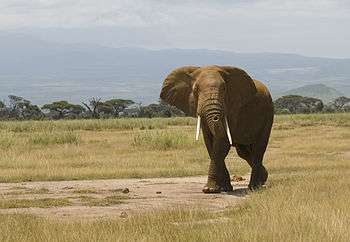Environmental issues in Kenya
Environmental issues in Kenya include deforestation, soil erosion, desertification, water shortage and degraded water quality, flooding, poaching, and domestic and industrial pollution.

Water resources
Water resources in Kenya are under pressure from agricultural chemicals and urban and industrial wastes, as well as from use for hydroelectric power. The anticipated water shortage is a potential problem for the future. For example, the damming of the Omo river by the Gilgel Gibe III Dam together with the plan to use 30% to 50% of the water for sugar plantations will create significant environmental problems. It is estimated that up to 50% of Lake Turkana's water capacity will be lost. Had there been no planning of the irrigation of sugar plantations, the dam itself might have had a net positive effect to the environment, due to the emission-less power generation of the dam.[1]
Water-quality in Kenya has problems in lakes, (including water hyacinth infestation in Lake Victoria), have contributed to a substantial decline in fishing output and endangered fish species.[2]
Animal poaching

There are a wide variety of wildlife species in Kenya, whose habitats are threatened by encroachment of man and the poachers that live in rural Kenya. Michael Werikhe aka Rhino Man, pioneered Kenyan wildlife conservation. Werikhe walked thousands of kilometres and raised millions of dollars to fund White Rhino conservation projects. The Blue Wildebeest is currently abundant, but like other more endangered species feels the pressure of habitat reduction. This wildlife consists of lions, elephants, gazelles, and rhinos.
Between 1970 and 1977, Kenya lost more than half of its elephants.[3] Though elephant hunting has been banned for 40-years in Kenya, poaching has not reduced. Given the poverty of many of the people, and the high value of elephant tusks, they are shipped overseas and sold on the black market. Although Kenya has many national parks and reserves protecting wildlife, elephant populations are still at risk, a problem which is made worse by corruption and some officials supplementing their income with permitting poaching.[4]
In 2020 February, Poachers in Kenya Killed two White Giraffes.[5] The Female White Giraffe and her calf were found dead in Garrisa County which is the North east part of the country.[6] This left the country and the world with only one white male giraffe.
Recently, as the Chinese sales of projects in Africa increase at a high annual growth rate, their contractors are encountering new challenges regarding wildlife protection during project construction. Using the Mombasa-Nairobi Standard Gauge Railway project constructed by the China Road and Bridge Corporation (CRBC).[7]
Deforestation
Forestry output has also declined because of resource degradation. Overexploitation over the past three decades has reduced the country's timber resources by one-half. At present only 2% of the land remains forested, and an estimated 50 square kilometres of forest are lost each year. This loss of forest aggravates erosion, the silting of dams and flooding, and the loss of biodiversity. Among the endangered forests are Kakamega Forest, Mau Forest and Karura Forest. In response to ecological disruption, activists have pressed with some success for policies that encourage sustainable resource use.
The 2004 Nobel Peace Prize went to the Kenyan environmentalist, Wangari Maathai, best known for organizing a grassroots movement in which thousands of people were mobilized over the years to plant 30 million trees in Kenya and elsewhere and to protest forest clearance for luxury development. Imprisoned as an opponent of Moi, Maathai linked deforestation with the plight of rural women, who are forced to spend untold hours in search of scarce firewood and water.
Widespread poverty in many parts of the country has greatly lead to over-exploitation of the limited resources in Kenya. Cutting down of trees to create more land for cultivation, charcoal burning business, quarrying among other social and occupational practices are the major threats of environmental degradation due to poverty in rural Kenya. Regions like Murang'a, Bondo and Meru are affected by this environmental issue.[8]
Littering and solid waste collection
.jpg)
Littering and the illegal dumping of rubbish is a problem in both urban and rural Kenya. Almost all urban areas of Kenya have inadequate rubbish collection and disposal systems uwongooo.[9]
Flooding
There is the risk of seasonal flooding during July to late August months. In September 2012, thousands of people were displaced in parts of Kenya's Rift Valley Province as floodwaters submerged houses and schools and destroyed crops.[10] It was especially dangerous as the floods caused latrines to overflow, contaminating numerous water sources. The floods can also cause mudslides and two children were killed in September 2012 following a mudslide in the Baringo District, which also displaced 46 families.[10]
References
- Jeppe Kolding | University of Bergen - Academia.edu
- Hecky, R. E. "Kenya National Water Qu ality Synthesis Report" (PDF). Seku Repository. Retrieved 27 December 2016.
- Douglas-Hamilton, Iain (August 1979). "AFRICAN ELEPHANT IVORY TRADE STUDY FINAL REPORT". savetheelephants.org. p. 19. Retrieved 9 May 2011.
- Anderson, David; Grove, Richard H. (25 May 1990). Conservation in Africa: Peoples, Policies and Practice. Cambridge University Press. p. 45. ISBN 978-0-521-34990-1. Retrieved 6 May 2011.
- "Rare white giraffes killed by poachers in Kenya". BBC News. 2020-03-10. Retrieved 2020-03-11.
- Francisco Guzman; Brian Ries. "Rare white giraffes killed by poachers at Kenyan wildlife sanctuary". CNN. Retrieved 2020-03-11.
- Jiang, Feng (June 2020). "Chinese contractor involvement in wildlife protection in Africa: Case study of Mombasa-Nairobi Standard Gauge Railway Project, Kenya". Land Use Policy. 95: 104650. doi:10.1016/j.landusepol.2020.104650. ISSN 0264-8377.
- "Archived copy" (PDF). Archived from the original (PDF) on 2011-11-25. Retrieved 2011-11-22.CS1 maint: archived copy as title (link)
- ""THE SOCIAL ECONOMIC HAZARDS OF PLASTIC PAPER BAGS LITTER IN PERI- URBAN CENTRES OF KENYA", THEURI DONALD WACHIRA, University of Nairobi, November 2013, page 20" (PDF). Archived from the original (PDF) on 2016-04-24. Retrieved 2016-04-16.
- KENYA: Floods displace thousands, destroy crops, Kenya: IRIN, 2012, retrieved 5 September 2012
![]()
.svg.png)